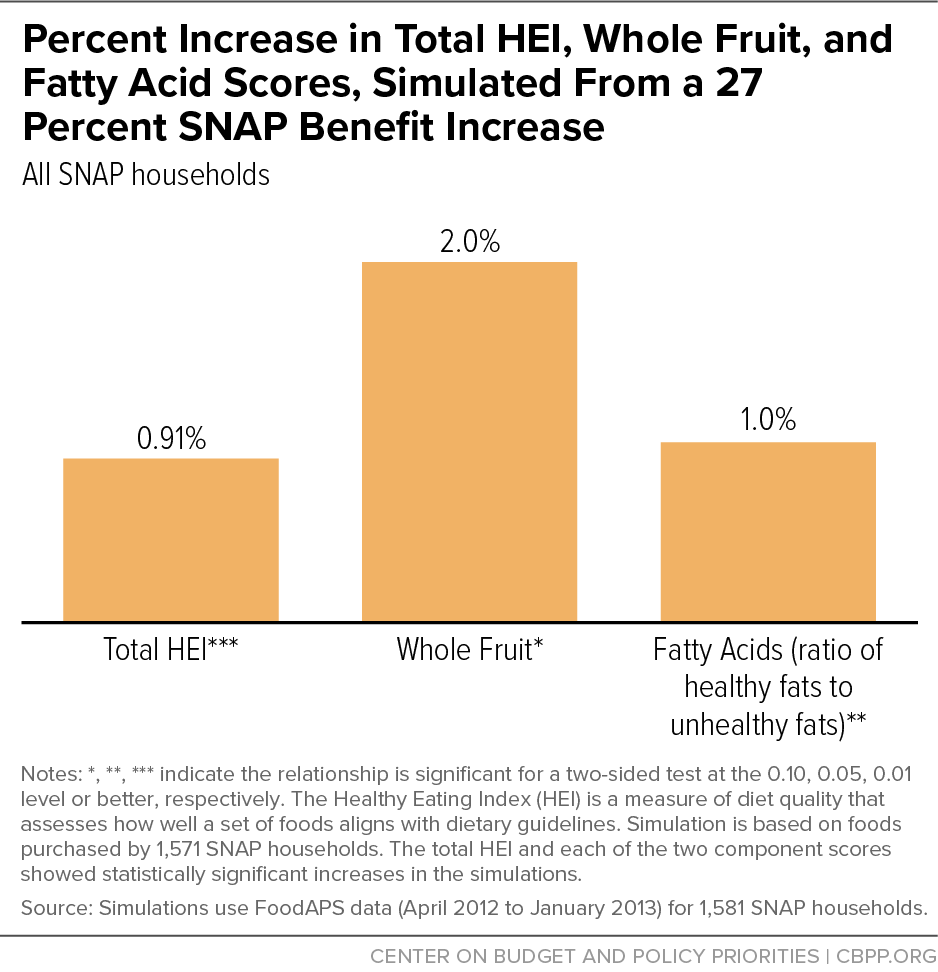New research finds that increasing SNAP benefits — as the U.S. Department of Agriculture recently did in response to a congressional directive from the bipartisan 2018 farm bill — is expected to increase low-income households’ spending on food prepared at home and improve the nutritional quality of the foods purchased, with slightly larger positive effects for households with children.[1] The study, by economists Michele Ver Ploeg and Chen Zhen, is the first to explore the potential impacts of the increase in SNAP benefits [equivalent to the 27 percent increase in average benefits due to the 2021 revision of the Thrifty Food Plan (TFP)[2]] on food spending and the nutritional quality of food purchases. It is also innovative in modeling the impact of SNAP benefit changes on detailed outcomes of diet quality, nutrient composition, food expenditures, and quantities of specific types of food.
The study simulates the impact of an increase in SNAP benefits on food spending, resulting in:
- Increased spending on groceries (food prepared at home) by $5.30 per household per week, or about 7 percent. The boost in SNAP benefits increases spending on food and means that benefits can cover a larger share of household food costs. This allows households to redirect funds they would otherwise have spent on food to other basic needs that SNAP doesn’t cover, such as rent, utilities, or medical care. This finding is consistent with studies that found that SNAP households’ food spending increased and food security improved after policymakers temporarily boosted SNAP benefits in response to the Great Recession. SNAP participants increased their food spending but also were able to redirect some of their cash income to spending on housing, education, and transportation. This suggests that increasing SNAP benefits allows participants to better meet both food and other needs, improving overall well-being by relieving pressure on their limited budgets. The SNAP benefit (including the increase) is still an in-kind benefit that must be spent on eligible food items for consumption at home.
- Larger food spending increases for food prepared at home, compared with food prepared away from home. All else equal, this aspect of SNAP likely encourages better nutrition among participants relative to nonparticipants, since foods purchased or acquired from restaurants tend to be lower in nutritional quality than foods purchased at grocery stores and other food retailers.[3]
- Small but statistically significant improvement in the overall nutritional quality of food purchases, based on the Healthy Eating Index, which is a measure of diet quality that assesses how well a set of foods aligns with dietary guidelines. (See Figure 1.)
- Small but statistically significant improvements to certain components of a healthy diet, such as the relative amount of whole fruit and the ratio of healthy fats to unhealthy fats in foods purchased. (See Figure 1.)
- Increased quantities of several key nutrients, such as iron and calcium, of about 6 percent, with slightly larger increases for households with children. (See Figure 2.)
Due to the time lag in data on food purchasing or consumption from federal surveys, analysis of the impacts of this recent change in SNAP benefits may not be possible for a year or more after the policy went into effect. But simulations of the anticipated impacts can be useful in the interim. The new TFP raised the average benefit from about $4.25 per person per day to about $5.45 in fiscal year 2022. (This does not include the temporary, pandemic-related increases that are in place in many states but will expire when the public health emergency declaration ends.)
A large body of research showed that, prior to this latest TFP revision, benefits fell well short of what households may need to ensure a healthy diet, with many running out of benefits before month’s end and increasing their risk of food insecurity. Studies have found that running out of benefits may harm participants’ health and educational achievement: hospital admissions and school disciplinary problems increase, and test scores fall among SNAP families later in the month.[4]
This study finds that the increase in SNAP benefits due to the revised TFP, while modest, may result in small but statistically significant improvements in the overall nutritional quality of food purchases. It may also increase the amount (per 1,000 kilocalories of food purchased) of fruit, the ratio of healthy fats and oils to unhealthy fats and oils, and several key nutrients, including fiber, calcium, and iron. These findings are consistent with recent research showing how SNAP and other interventions that provide access to affordable, nutritious food and reduce food insecurity have been linked to better health for young children as well as long-term improvements in health and longevity; greater high school completion; and higher earnings and self-sufficiency in adulthood, whether by improving nutrition or reducing harmful stress.[5]
Ver Ploeg and Zhen’s study estimates how SNAP households would respond to a benefit increase by using an economic approach called demand system analysis and data from a federal household survey on food purchases. Demand system analysis uses household characteristics that are good predictors of food spending patterns to estimate how these patterns would change if household characteristics (such as income from SNAP) or food prices were to change. This system accounts for household preferences across food groups and other non-food goods and can be used to estimate the effects of an income increase or price increase on the demand for a given good, but also on demand for other closely related goods. The study uses data from the National Household Food Acquisition and Purchase Survey (FoodAPS), which includes detailed information on the nutrient composition, expenditures, and quantities purchased for specific foods by households, and on SNAP participation and benefit amounts. This information is validated using administrative records to avoid issues of underreporting that occur in other household surveys. The FoodAPS data provide information about how people spend their income (including SNAP benefits) at different income and benefit levels. Demand system analysis can simulate how a SNAP household receiving an additional $1 in benefits per day might allocate the $1 of their budget freed up by the additional benefit. They might spend about $0.30 on additional groceries and $0.70 on other necessities. Of the additional spending on groceries, a fraction of that might be spent on increasing fruit and vegetable purchases.


